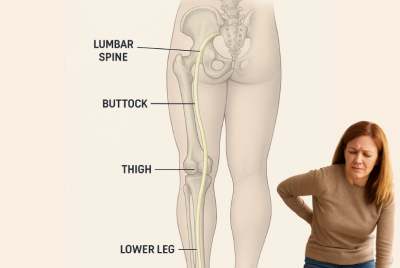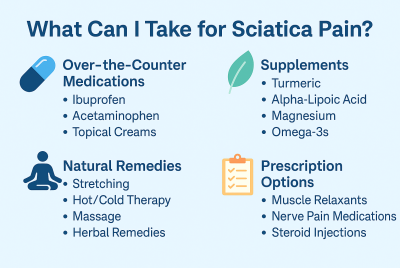Foods to Eat for Sciatica Relief
Discover the best foods to eat for sciatica relief! Learn how anti-inflammatory meals can reduce pain and support nerve health. Sciatica can be a real pain—literally. If you’re dealing with that sharp, radiating ache that shoots down your lower back and legs, you know how much it can impact daily life. While treatments like physical therapy and medications can help, you might be surprised to learn that the right foods can also significantly ease sciatic pain. Let’s dive into how your diet can become part of your sciatica relief strategy.
What is Sciatica?
Sciatica is often caused by pressure on the sciatic nerve, which runs from your lower back through your hips, buttocks, and down each leg. This pressure could be due to herniated discs, bone spurs, or even certain lifestyle factors. Symptoms can range from mild tingling to severe pain, impacting mobility and comfort.
Why Does Diet Matter for Sciatica?
When you think of managing sciatica, food might not be the first thing that comes to mind. However, what you eat can directly affect inflammation and nerve health, both of which are crucial in managing sciatica pain. Eating the right foods can help reduce inflammation, support nerve health, and ultimately lessen pain.
How to Cure Sciatica Pain Naturally
Anti-Inflammatory Foods for Sciatica
Inflammation often exacerbates sciatica pain, so targeting inflammation through diet is a smart approach.
Why Inflammation Affects Sciatica Pain
Inflammation can increase pressure around the sciatic nerve, making it harder for you to get relief. You’re essentially helping to “calm down” that nerve by eating anti-inflammatory foods.
Omega-3 Rich Foods
Omega-3 fatty acids are powerful anti-inflammatories. Include fatty fish like salmon, sardines, and mackerel in your diet. If you’re plant-based, consider chia seeds, flaxseeds, and walnuts. These foods help soothe inflammation around the sciatic nerve, reducing flare-ups and easing pain.
Fruits and Vegetables High in Antioxidants
Brightly colored fruits and veggies like berries, bell peppers, and spinach are packed with antioxidants that help fight inflammation. Blueberries, strawberries, and oranges are particularly beneficial. These foods are like natural “painkillers” that work gradually to reduce sciatica discomfort.
Nuts and Seeds
Walnuts, almonds, and sunflower seeds are excellent for snacking and are loaded with anti-inflammatory compounds. They also offer healthy fats, fiber, and protein, making them perfect for keeping you satisfied and aiding in nerve health.
Foods Rich in Vitamins and Minerals
Certain vitamins and minerals can make a big difference when it comes to nerve health.
Vitamin B12 and Sciatica Relief
Vitamin B12 supports nerve regeneration and can help reduce nerve-related pain, which is essential if you’re dealing with sciatica.
Sources of Vitamin B12
To get enough B12, consider foods like eggs, dairy products, and fish. If you follow a plant-based diet, you might need to look into fortified foods or supplements to ensure you’re getting enough B12.
Vitamin D for Bone and Nerve Health
Vitamin D is another key player in bone and nerve health, and deficiencies in this vitamin can worsen sciatica symptoms.
Best Food Sources of Vitamin D
Foods like fatty fish, fortified milk, and eggs can help you get your daily dose of Vitamin D. Sun exposure is also an excellent source, but if you’re inside often, these foods can fill the gap.
Magnesium-Rich Foods for Nerve Health
Magnesium is essential for nerve function and muscle relaxation, which can help relieve the tension around the sciatic nerve.
Top Magnesium-Rich Foods
Leafy greens, bananas, avocados, and dark chocolate are fantastic sources of magnesium. Incorporating these foods regularly could help soothe muscle tightness and nerve irritation.
Hydration and Sciatica
Importance of Staying Hydrated
Keeping hydrated is essential for spinal and nerve health. Dehydration can lead to stiff muscles and joints, increasing pressure on the sciatic nerve.
Best Hydrating Foods and Drinks
In addition to drinking plenty of water, try consuming water-rich foods like cucumbers, melons, and oranges. Herbal teas, coconut water, and broths are also great for hydration.
Foods to Avoid for Sciatica
Just as certain foods can help, others can worsen sciatica pain. Here’s what you should consider cutting back on.
Processed Foods and Sugary Snacks
Processed foods and sugary treats can increase inflammation and may even trigger pain. Aim to limit fast food, sugary snacks, and other highly processed items.
Alcohol and Sciatica Pain
Alcohol can dehydrate you and exacerbate inflammation, making it harder to manage sciatica pain. Try to limit your intake or avoid it altogether if you notice it triggers pain.
Excessive Caffeine
Caffeine, when consumed in excess, can tighten muscles and increase tension around the sciatic nerve. Moderation is key; consider switching to herbal tea if you’re a heavy coffee drinker.
Building a Sciatica-Friendly Meal Plan
What foods to eat for sciatica relief and to make it easier to follow these dietary tips, here’s a sample meal plan focused on reducing sciatica pain.
Sample Meal Plan for Sciatica Relief
Breakfast Ideas
For an anti-inflammatory start to the day, try oatmeal topped with berries and chia seeds or a smoothie with spinach, banana, and almond milk.
Lunch Ideas
Consider a salad with mixed greens, grilled salmon, avocado, and a sprinkle of walnuts for a satisfying, nerve-supportive lunch.
Dinner Ideas
Opt for a meal like baked sweet potato with a side of steamed broccoli and grilled chicken. This combination is rich in vitamins, antioxidants, and protein.
Tips for Sticking to a Sciatica-Friendly Diet
Sticking to a sciatica-friendly diet can feel challenging at first, but with a few practical tips, it’s much easier to stay on track. Here are some helpful strategies to keep you committed to a diet that supports sciatica relief:
Meal Prep in Advance
Preparing meals in advance saves time and helps you avoid reaching for unhealthy options. Try batch-cooking meals rich in anti-inflammatory ingredients, like roasted vegetables, grilled fish, or quinoa bowls. Portion them out so you can grab a quick, healthy meal without much effort.
Keep Healthy Snacks Accessible
Stock up on snacks that are rich in fiber, healthy fats, and protein to curb cravings for processed foods. Nuts, seeds, berries, and chopped veggies are great to have on hand and can help you avoid sugary snacks.
Plan Your Shopping List Around Sciatica-Friendly Foods
Going to the store with a plan can help you stay focused. Make a shopping list of foods like leafy greens, berries, fish, and whole grains. To minimize temptation, avoid the aisles with processed snacks and sugary drinks.
Stay Hydrated
Hydration is key for nerve and muscle health. Keep a water bottle with you, and add hydrating foods to your meals, like cucumbers, oranges, and watermelon. Staying hydrated also helps control cravings and supports your energy levels.
Try Healthier Versions of Your Favorite Foods
If you crave certain comfort foods, find ways to make healthier versions. For example, if you love pasta, consider zucchini noodles or whole-grain pasta with an anti-inflammatory pesto sauce. Enjoying modified favorites can help you stick with your plan.
Add Variety to Avoid Boredom
Eating the same foods can get tiresome, so experiment with different recipes and ingredients. Try different types of fish, vary your vegetables, or incorporate new herbs and spices to keep meals interesting and enjoyable.
Set Small, Achievable Goals
Instead of overhauling your diet all at once set small, realistic goals. Start with one new habit, like adding more greens to your meals, and build from there. This approach makes it easier to stick with changes without feeling overwhelmed.
Mindfully Monitor How You Feel
Pay attention to how your body responds to dietary changes. Noticing improvements in pain or energy levels can be motivating and reinforce the benefits of your new diet.
Treat Yourself Occasionally
Allow yourself a treat now and then without guilt. Knowing you can enjoy a favorite treat occasionally can prevent the urge to stray too far from your sciatica-friendly plan.
Join a Support Group or Find an Accountability Partner
It can help to have someone to check in with, whether it’s a friend, family member, or online support group. Sharing your journey and progress makes it easier to stay consistent and receive encouragement when you need it.
Integrating these tips into your routine can make a sciatica-friendly diet feel more manageable, sustainable, and enjoyable. With consistency, you’re likely to see positive changes that impact your sciatica symptoms and overall well-being.
FAQs Related to Foods to Eat for Sciatica Relief
What fruits help with sciatica pain?
Berries, oranges, and cherries are excellent choices, packed with antioxidants to reduce inflammation.
Are there any drinks that relieve sciatica?
Herbal teas, water, and coconut water are great for hydration and inflammation control.
Can certain foods trigger sciatica pain?
Yes, processed foods, sugary snacks, alcohol, and excessive caffeine can worsen symptoms.
How long does it take to see results from a sciatica-friendly diet?
Results vary, but many people notice improvements within a few weeks of consistent healthy eating.
Are supplements useful for sciatica relief?
Certain supplements, such as B12, magnesium, and omega-3s, can support nerve health, but consult a doctor before starting any.
Is a vegetarian diet beneficial for sciatica?
A vegetarian diet rich in anti-inflammatory foods can help; just be mindful to get enough B12 and omega-3s.
What foods to eat for sciatica relief?
Focus on anti-inflammatory foods like fatty fish, leafy greens, berries, nuts, and seeds. Add vitamin-rich foods, including those with B12 and magnesium, to support nerve health and reduce pain.
Foods to Eat for Sciatica Relief – Conclusion
While diet alone won’t cure sciatica, here are some effective tips for sciatica pain relief. But the right foods can certainly help you manage it more effectively. By focusing on anti-inflammatory foods and avoiding potential triggers, you can take a proactive approach to reduce pain and improve your quality of life. Remember, every small dietary choice you make is a step toward a pain-free life!
Disclaimer
Please note that this article should not replace professional medical advice. Consult a healthcare professional for an accurate diagnosis and tailored treatment plan.






